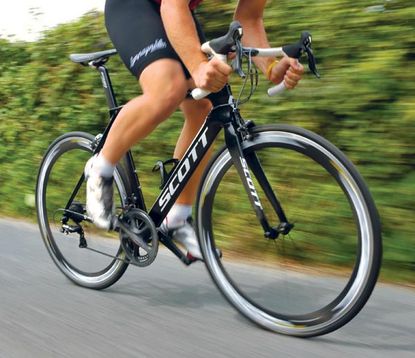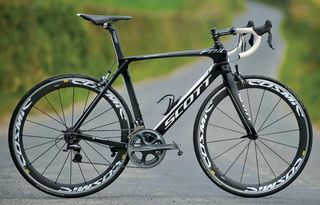Scott Foil R1 review

When HTC-Highroad tested this frame at the 2010 Tour de France (Cav won five stages on a prototype) they came away saying 'great, fast, but way too stiff' - to be fair Scott had made the frame as requested but it claimed to have taken note all the same and production models are supposed to be a lot more forgiving. If that were the case, we would hate to have felt how rigid those protos were. The Foil is incredibly stiff. For silky, Euro roads this is all well and good but in the UK we rarely have that luxury. On long rides, the buzz through the hands and feet kills you. Aching hands, numb fingers and hotspots in feet were reported. As a race bike that is designed for nothing but pure performance, some bigger riders may be able to put up with it but, in our opinion, Scott has a few tweaks to make before the Foil wins this particular race. Contact: www.scott-sports.com
-
+
Incredibly stiff
-
+
Lightweight
-
-
Unforgiving ride
You can trust Cycling Weekly.
When Scott decided to enter the aero bike arena, it had some different design parameters to many other manufacturers: the bike would have to be a stiff as their current race machine, the Addict, and within five per cent of its weight - as well as being very, very slippery.
Traditionally aero bikes use NACA (the American National Advisory Committee for Aeronautics) aerofoil shapes. The problem here is that the narrow shapes aren't a stiff as standard oversize tubing. To counteract this, thicker walls are used to resist some of the loads. The result? Heavier, flexier bikes. So Scott turned to Simon Smart. The ex-F1 aerodynamicist has come up against similar problems when trying to improve the performance and airflow around the suspension struts on Red Bull Racing's cars.
Truncated aerofoils are not new - Trek uses a similar design (a Kamm tail) on its Speed Concept TT bike but rather than simply slice the rear section off an aerofoil, Smart had found out in his previous life that the rear curvature, and its changing transition had a huge impact on the air's ability to mimic a full aerofoil's shape.
Thanks to his exclusive access to the Mercedes Petronas GP wind tunnel, he was able to research tubing shapes across the differing dimensions needed for various applications on the frame. The resultant tubes use effective aerofoils with profiles ranging from three-to-one up to 11-to-one, all staying within the UCI's limit of three-to-one for any bicycle component.
In fact, the torsional-load-resisting top and down tubes are three-to-two. The result is a supremely stiff structure that, according to Scott's data, is within a gnat's of the aero market leaders. With one part complete, it could go about finalising the lay-up to maintain self-imposed stiffness numbers.
Scott didn't only match the Addict's figures, the Foil is actually stiffer at both the head tube and bottom bracket. Two out of three wouldn't be bad, but thanks to fastidious attention to detail, the weight element was knocked into submission. Miniscule 17g full-carbon dropouts with shorter tubing overlap saved nearly 40g, carbon BB and headset bearing inserts a few more and improvements in the Integrated Moulding Process reduced internal joint material by 11 per cent.
The use of proprietary high-modulus fibres (HMX) allow stiffness to be added without excess bulk and the Naked External Tubing (NET) does away with a final cosmetic layer to save more weight. The result: an 840g finished frame weight compared to 790g from the Addict.
Hanging a full Dura-Ace groupset off such a frame and rolling it on Mavic's all-rounder Cosmic Carbone SL wheels would seem to be the makings of an exceptionally good bike, then. The stiffness numbers, low mass and wind tunnel data are all well and good but, as ever, the truth will always out.


Thank you for reading 20 articles this month* Join now for unlimited access
Enjoy your first month for just £1 / $1 / €1
*Read 5 free articles per month without a subscription

Join now for unlimited access
Try first month for just £1 / $1 / €1
Get The Leadout Newsletter
The latest race content, interviews, features, reviews and expert buying guides, direct to your inbox!
Founded in 1891, Cycling Weekly and its team of expert journalists brings cyclists in-depth reviews, extensive coverage of both professional and domestic racing, as well as fitness advice and 'brew a cuppa and put your feet up' features. Cycling Weekly serves its audience across a range of platforms, from good old-fashioned print to online journalism, and video.
-
 Egan Bernal says he has regained his pre-crash form, but others have improved
Egan Bernal says he has regained his pre-crash form, but others have improvedColombian, who suffered traumatic training accident in 2022, aiming for return to Tour de France
By James Shrubsall Published
-
 Lotte Kopecky to miss Tour de France Femmes with Olympics the main goal
Lotte Kopecky to miss Tour de France Femmes with Olympics the main goalWorld Champion set to ride Tour of Britain Women and Giro d'Italia Donne before Paris games
By Tom Thewlis Published
-
 Specialized has joined the price slashers and there are huge discounts to be had on electric, hybrid and gravel bikes
Specialized has joined the price slashers and there are huge discounts to be had on electric, hybrid and gravel bikesHalf price savings go live on the Specialized website as industry chaos continues
By Michelle Arthurs-Brennan Published